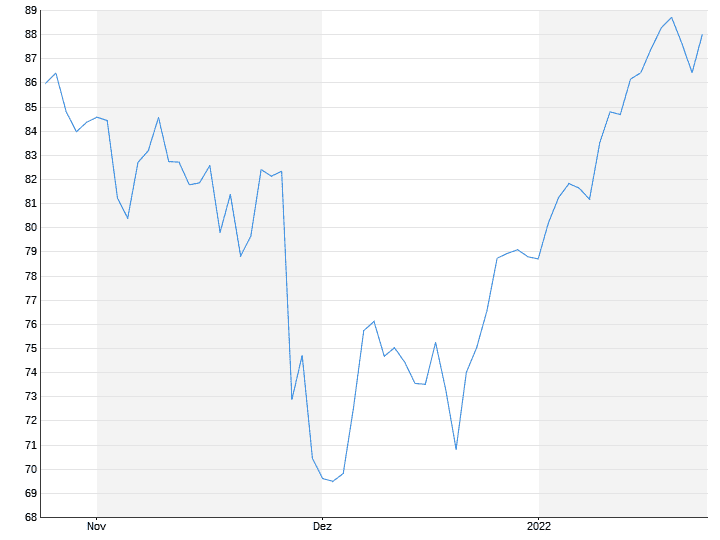Inflation causes price losses
Investors driven by nervousness
01/25/2022 10:33 p.m
Not only the interest rate of the US Federal Reserve, but also the Ukraine crisis are causing uncertainty on the stock exchange. The courses hold up a mirror to the central bank if interest rates are too high. The Dow Jones is falling, but not as much as the Nasdaq Composite.
Nervousness also characterized trading on Wall Street on Tuesday and caused the indices to drop significantly at times. Similar to Monday, bargain buying kicked in in late trading, allowing prices to pare losses. However, the price fluctuations were not nearly as spectacular as at the beginning of the week and the markets were unable to turn positive. In addition to uncertainty about the future interest rate of the US Federal Reserve, the ongoing Ukraine crisis is currently unsettling investors.
However, encouraging signals from the reporting season that is just beginning eased concerns somewhat. the Dow Jones Index was still 0.2 percent lower at the close of trading after having been more than 2 percent in the red at the daily low. The Dow was led by American Express (Amex) and IBM, whose payment cards were well received. the S&P 500 fell by 1.2 percent. For the Nasdaq Composite was down 2.3 percent. 1462 (Monday: 1518) stocks recorded price gains, while 1953 (1966) saw losers and 111 (110) stocks closed unchanged. Some market participants were relaxed about the slide in prices. This is the usual behavior of the stock market before a US Federal Reserve meeting, it said.
The market is signaling to the Fed what could happen if it is too harsh in raising interest rates, or worse, shrinking its balance sheet. The US Federal Reserve will decide on its further course of monetary policy on Wednesday in view of the extremely high inflation. US markets are likely to remain volatile at least until the Fed’s first rate hike, according to Jason Liu, head of Asia’s investment office at Deutsche Bank.
A first rate hike is not expected until the March meeting. Above all, there is uncertainty about how many further interest rate hikes will follow this year and how severe they will be. So far, four interest rate hikes have been agreed on the market. The statements by Fed President Jerome Powell are therefore eagerly awaited. On the economic side, consumer confidence did not deteriorate as much as expected in January, as the corresponding index of the research institute Conference Board showed. However, the reporting season, which was gaining momentum, also brought movement to the individual stocks.
Good figures inspire Amex and IBM
For the share of IBM was up 5.7 percent. In the fourth quarter, the group surprisingly increased sales and profits compared to the previous year. In addition, IBM boss Arvind Krishna was confident for the current financial year. American Express (Amex) benefited from increased credit card payments in the fourth quarter, beating market expectations. However, the company posted provisions for loan losses of over $53 million. For 2022, the group expects significant double-digit sales growth. This helped the share price jump by 8.9 percent. General Electric (GE) lost 6.0 percent. High burdens, for example for restructuring measures, brought the group a billion-dollar loss in the fourth quarter. The company posted adjusted earnings that were higher than analysts had expected.
Biontech (+3.7%) and partners Pfizer (+1.9%) have developed an omicron-based vaccine candidate, which they are now sending into a clinical trial. The safety, tolerability and immunogenicity of the vaccine candidate against the now predominant omicron variant of the corona virus are being examined, as the companies announced. Johnson&Johnson (+2.9%) recorded higher sales in all three segments in the fourth quarter and increased profit significantly. The group benefited from sales of its Covid 19 vaccine.
Telecommunications group Verizon (-0.1%) earned more than expected in the fourth quarter. The continued switch of customers to unlimited tariffs has driven the growth in mobile phone sales, said Verizon Communications and gave a positive outlook for earnings in the current year. The conglomerate 3M (+0.5%) earned less in the fourth quarter due to the consequences of global supply bottlenecks. However, 3M Corp comfortably exceeded market expectations.
Anticipation of production bottlenecks driving oil prices

The dollar held up well on the foreign exchange market. The dollar index gained 0.1 percent. The euro fell to around $1.1300 from around 1.1320 the previous day. MUFG expects a further appreciation of the dollar in the short term, especially since the Fed is likely to confirm the tightening course it has initiated. The dollar was also supported by the ongoing geopolitical tensions in Eastern Europe.
On the bond market, prices fell somewhat as the stock market recovered. The ten-year yield rose by a good 1 basis point to 1.78 percent. the oil prices were initially volatile and rose sharply in late trading. Market participants referred to the uncertainties surrounding Russia and Ukraine. Capacity constraints and other production issues at Opec+ producers could mean supply rising at a slower pace than the agreed monthly increase of 400 million barrels per day, analysts at ING said. Gold benefited somewhat from the Ukraine crisis. However, Brien Lundin, editor of Gold Newsletter, saw short covering from market participants who had bet on a falling gold price in anticipation of rate hikes. Higher interest rates reduce the attractiveness of the precious metal, which is held interest-free.
